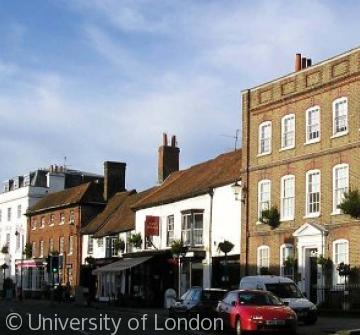Hart Street

Hart Street is one of Henley's four main streets, leading from the Market Place and central crossroads to St Mary's parish church and the bridge over the River Thames (see map). It forms part of the original medieval street plan, which was laid out when the planned town was created in (probably) the 12th century. In the Middle Ages it was called High Street - its later name derives from the White Hart Inn on its northern side, which was recorded in 1428-9, and was an important inn into modern times.
Hart Street's width suggests that it was part of the medieval market area, and until the mid 18th century a row of medieval buildings stood in the middle of the street near the crossroads. (A similar row, called the Middle Row, stood in the middle of the Market Place beyond the crossroads, and included the medieval Guild Hall.) Many houses in Hart Street (and elsewhere in the town) owed 'bridge rents', which were established in the Middle Ages in support of the church and bridge. These rents continued until 1967, when they were finally commuted in exchange for one-off down payments. The street now has a predominantly Georgian aspect, its buildings generally fronted with warm brick (e.g. the Red Lion Inn by the bridge), or white render. But several frontages hide much older buildings, among them the medieval White Hart Inn. Other houses have their medieval or 17th-century frontages exposed (e.g. 20-22 Hart Street, Speaker's House). The Catherine Wheel Inn has been largely rebuilt, but was first mentioned in 1499. Long before the 19th century Hart Street was home not only to local shops and businesses, but to professional and well-to-do inhabitants including merchants, attorneys and surgeons. As the censuses show, such people had their own domestic servants, who sometimes lived on the premises. The well-to-do were also served by an underclass of washerwomen, gardeners and ostlers who often lived in squalid insanitary tenements. An example was Barlows Yard (now demolished), which was entered from Hart Street's south side. Until 1830 Bishop Longland's Almshouses (founded in 1547) stood south of Hart Street near the bridge. They were rebuilt on the west side of the churchyard that same year, opposite the Messenger and Newbury Almshouses on the churchyard's other side. Read more:
- 19th-century census transcripts by the Henley Census Group (see Assets to right)
- (abbreviations used in census transcripts)
- White Hart Inn - 20-22 Hart Street - Speaker's House - bridge
.
Did You Know? - that Blandy House on the north of Hart Street was home to the Henley solicitor and town clerk Francis Blandy, who was notoriously poisoned by his daughter Mary Blandy in 1751. (Read more - NB this link takes you away from the EPE website)
Content generated during research for the paperback book 'Henley-on-Thames: Town, Trade and River' (ISBN 13 : 978-1-86077-554-3) for the England's Past for Everyone series








